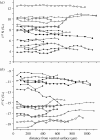Individual specialists in a generalist population: results from a long-term stable isotope series
- PMID: 20335202
- PMCID: PMC2936143
- DOI: 10.1098/rsbl.2010.0124
Individual specialists in a generalist population: results from a long-term stable isotope series
Abstract
Individual variation in resource use has often been ignored in ecological studies, but closer examination of individual patterns through time may reveal significant intrapopulation differences. Adult loggerhead sea turtles (Caretta caretta) are generalist carnivores with a wide geographical range, resulting in a broad isotopic niche. We microsampled scute, a persistent and continuously growing tissue, to examine long-term variation in resource use (up to 12 years) in 15 nesting loggerhead turtles. Using stable isotopes of nitrogen and carbon, we examined the resource use patterns (integration of diet, habitat and geographical location) and demonstrate that individual loggerheads are long-term specialists within a generalist population. We present our results in the context of a conceptual model comparing isotopic niches in specialist and generalist populations. Individual consistency may have important ecological, evolutionary and conservation consequences, such as the reduction of intraspecific competition.
Figures


References
-
- Barnes C., Jennings S., Polunin N. V. C., Lancaster J. E.2008The importance of quantifying inherent variability when interpreting stable isotope field data. Oecologia 155, 227–235 (doi:10.1007/s00442-007-0904-y) - DOI - PubMed
-
- Bearhop S., Adams C. E., Waldron S., Fuller R. A., Macleod H.2004Determining trophic niche width: a novel approach using stable isotope analysis. J. Anim. Ecol. 73, 1007–1012 (doi:10.1111/j.0021-8790.2004.00861.x) - DOI
-
- Bjorndal K. A.1997Foraging ecology and nutrition of sea turtles. In The biology of sea turtles, vol. 1 (eds Lutz P. L., Musick J. A.), pp. 199–230 Boca Raton, FL: CRC Press
-
- Bolnick D. I., Svanback R., Fordyce J. A., Yang L. H., Davis J. M., Hulsey C. D., Forister M. L.2003The ecology of individuals: incidence and implications of individual specialization. Am. Nat. 161, 1–28 (doi:10.1086/343878) - DOI - PubMed
-
- Cherel Y., Kernaléguen L., Richard P., Guinet G.2009Whisker isotopic signature depicts migration patterns and multi-year intra- and inter-individual foraging strategies in fur seals. Biol. Lett. 5, 830–832 (doi:10.1098/rsbl.2009.0552) - DOI - PMC - PubMed
Publication types
MeSH terms
Substances
LinkOut - more resources
Full Text Sources
